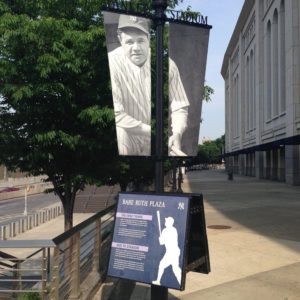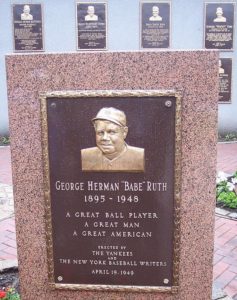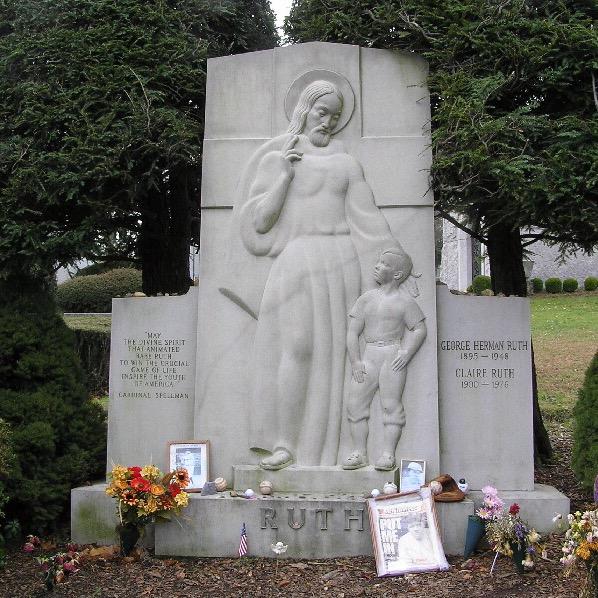by John Semlak | May 24, 2017 | #NYCSports
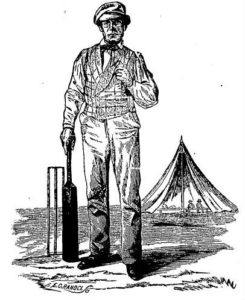 A lithograph of Samuel Wright from an 1856 issue of the New York Clipper, captioned “Veteran Sam, the well-known cricketer.’
A lithograph of Samuel Wright from an 1856 issue of the New York Clipper, captioned “Veteran Sam, the well-known cricketer.’
Yesterday was the 205th birthday of American cricketer Samuel Wright, the father of two baseball hall-of-famers, Harry and George Wright. Though a fairly obscure figure in American history (he didn’t have a Wikipedia page until I created one last week), he became the patriarch of the Wright family which would have profound influence on the sporting scene in America–in baseball as well as golf, tennis and cricket. The family produced two US Open tennis champions and three major league baseball stars, but the legacy runs much deeper than that.
Samuel Wright was born on May 22 1812 in Sheffield England (thanks to blogger and historian Mark Aubrey for the info). He married Ann Tone (niece of Irish nationalist Wolfe Tone, whose wife Matilda is buried at Green-Wood Cemetery in Brooklyn) in 1830. In 1832 they gave birth to their first son William Henry Wright–known as ‘Harry’ (There is some debate about Harry’s birth date–some sources put it at 1835). At some point in the 1830s they moved to the United States and settled in New York City. Samuel Wright, who was an unremarkable cricketer in England, appears to have chosen to try to come to play professional cricket in the US. He joined the St George’s Cricket Club in New York, American’s most feared cricket team, nicknamed the ‘Dragonslayers’. He served as a groundskeeper and a player for over two decades. He was known as a strong batsman (as batters are referred to in cricket) and bowler. This was before baseball had established itself as the American’s most popular team sport. Cricket was a very prominent sporting activity and matches were covered in the press. St. George had rival clubs in Toronto, Philadelphia, and Staten Island.
Samuel and Ann gave birth to three more sons and a daughter in New York. Three of their sons would become prominent baseball players, though they would also play cricket–at the time it was common for baseball players to play cricket as well.
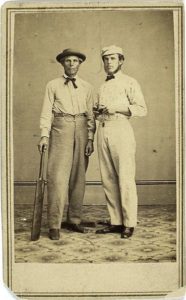 An 1863 photo by Mathew Brady of Samuel Wright, left, holding a cricket bat, and Harry Wright holding a baseball.
An 1863 photo by Mathew Brady of Samuel Wright, left, holding a cricket bat, and Harry Wright holding a baseball.
Harry Wright played with his father at the St George’s Cricket Club but he became acquainted with baseball early on at the Elysian Fields in Hoboken, home to both St George and the Knickerbockers, one of the first baseball clubs. He would play baseball for the Knickerbockers and the New York Gothams, In 1866 he moved to Cincinnati to play for the Union Cricket Club, but a year later he was playing baseball again. He became the manager and center-fielder for the Cincinnati Red Stockings, the first fully professional baseball team in America. The team, bolstered by stars including his younger brother George Wright at shortstop, went on an 84-game winning streak. On June 14th 1870, the streak game to an end in front of 20,000 people at Brooklyn’s Capitoline Grounds when the Red Stockings lost to the Atlantics 8-7 in ten innings. The score was tied 5-5 after 9 and by the rules of the time could have ended in a tie; but Harry Wright asked to continue.
The Red Stockings would fold in 1871 due to the expense of maintaining baseball’s first all-professional club. However, the nickname of the Cincinnati Reds is an homage to the team Wright managed. Wright then went to Boston, and managed the newly formed club the Boston Red Stockings until 1877. That team was one of the founding members of the National League in 1876 and would later change to the Boston Braves, and now exist as the Atlanta Braves. They wear red on their uniform as an reference to their origins. It is the oldest professional baseball club in the US. Harry Wright would later manage the Providence Grays and the Philadelphia Quakers (today the Phillies).
Harry Wright’s baseball career stretched from the sport’s origins in New York to the establishment of professional baseball and the formation of the National League. Historian Bill James said of Wright, “Harry didn’t play in the major leagues; he just invented them.” He also organized a baseball tour of England which included an exhibition match between Boston Red Stockings and Philadelphia Athletics at Lords Cricket Ground.
Harry’s brother George was a star on both his Cincinnati and Boston teams–one of the greatest shortstops of his time. He settled in Boston and founded the Wright & Ditson Sporting Goods company. It still exists today. He also played cricket at the Longwood Cricket Club. He became interested in golf and created America’s second public golf course called Franklin Park in Boston. He also donated land to the city which was turned into another golf course that bears his name today: The George Wright Golf Course.
George Wright had two sons who became champion tennis players. Beals Wright won the 1904 Singles and Double’s Olympic gold medals in tennis, and in 1905 won the US Open. His brother Irving Wright was a two-time mixed doubles champion at the US Open. George Wright’s younger brother Sam Wright Jr., Samuel Wright Sr.’s youngest son, was also a professional baseball player for 4 teams.
With a family sporting prowess that stretched across three generations, a legacy that is still seen today in at least four major cities, and with significant impact on the sports of baseball, cricket, golf, and tennis, no family has impacted the American sports landscape like the Wrights have. And it started with a cricketer from Sheffield who came to New York like millions of others in search of a new life.
by John Semlak | Feb 18, 2017 | #LincolninNewYork, #NYCHistory
Until the election of the 45th President, New York City didn’t immediately conjure up presidential imagery. The most popular attractions–the Empire State Building, Statue of Liberty or Central Park aren’t closely connected to the presidency. But New York has deep roots connected to the US presidency. Two presidents were born here. Three died here. Two were inaugurated here. Three presidents and one vice-president studied at Columbia University in New York. One president is interred here. Five First Ladies were born in New York, and nine from New York State. Four vice-presidents died in New York. And nearly every president came to New York City at some point.
Aside from Donald Trump, the US presidents that loom the largest in New York are George Washington and Theodore and Franklin Roosevelt. There are numerous attractions related to all three in and around New York City.
 The Washington Square Arch in Greenwich Village, built to commemorate Washington’s inauguration in NYC
The Washington Square Arch in Greenwich Village, built to commemorate Washington’s inauguration in NYC
Washington was from Virginia of course but he spent much time in New York. He commanded the Continental Army in New York during the Revolutionary war and there are several buildings in New York or the surrounding area that Washington used has headquarters, including the Morris Jumel Mansion in Washington Heights. The Old Stone House in Brooklyn is a museum that documents the Battle of Brooklyn between Washington’s Continental Army and the British.
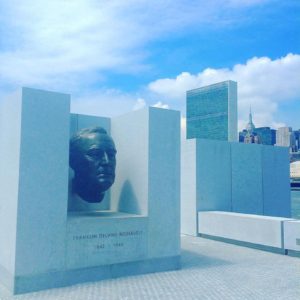 Bust of Franklin Roosevelt at Four Freedoms Park on Roosevelt Island
Bust of Franklin Roosevelt at Four Freedoms Park on Roosevelt Island
From 1785-1791, New York City was the capital of the United States. Thus, in 1789, the first presidential inauguration took place in NYC. Washington lived in two homes during his time in NY, neither of which survive but plaques mark their spots. There are nine full-sized statues of the 1st US president in NY, as well as the Washington Square Arch in Washington Square.
However, the presidential family that has the deepest ties to New York, with due respect to the 45th president, is the Roosevelt family. Descended from Dutch settlers in New Amsterdam, the Roosevelts represented old New York society. Franklin and Theodore came from different branches of the family and were 5th cousins. Both families were from New York, but they spent summers in two different countryside locations–Theodore’s side in Oyster Bay on Long Island, and Franklin’s side in Hyde Park in upstate New York. Both lived in New York for significant periods of time.
Aside from Washington and the Roosevelts, many other presidents have ties to New York City. Below is a list of 10 places you can visit in New York City that have connections with one or more presidents–most are buildings that presidents visited. Also there are three worthwhile sites outside of New York that are accessible by car or train. Most of the sites in New York City are free to visit.
 Federal Hall on Wall Street, site of Washington’s 1st inauguration. In front is a statue of Washington by John Quincy Adams Ward
Federal Hall on Wall Street, site of Washington’s 1st inauguration. In front is a statue of Washington by John Quincy Adams Ward
Federal Hall
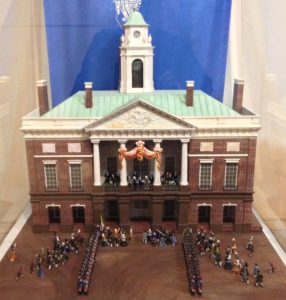 Model of the original Federal Hall and Washington’s Inauguration.
Model of the original Federal Hall and Washington’s Inauguration.
Federal Hall was the first Capitol of the United States, and the site of George Washington’s inauguration in 1789, as New York City was the capital of the US until 1791. Though the actual Federal Hall was destroyed in 1812, you can visit the Federal Hall National Memorial on Wall Street at the same location. The building was built in 1842–a beautiful Greek Revival building that originally served as the United States Customs House. The Memorial is free to visit and contains many wonderful artifacts and exhibits including the pavestone where Washington stood for his inauguration, the Washington Bible, and a scale model of the original Federal Hall. Outside is an 1882 statue of George Washington by sculptor John Quincy Adams Ward.
Fraunces Tavern
 Fraunces Tavern at the corner of Pearl and Broad Streets
Fraunces Tavern at the corner of Pearl and Broad Streets
Fraunces Tavern, originally founded by Samuel Fraunces in 1762, is situated a short walk down Broad Street from Federal Hall. Though most of the building is a reconstruction, it stands a a beautiful example of Colonial Revival architecture. It still functions as a tavern and a museum on the upper floors. The highlight of the museum is the Long Room, a recreation of the banquet hosted by George Washington on December 4th 1783 when he resigned from the Continental Army. Other exhibits highlight New York’s role in the American Revolution.
Historically Fraunces Tavern played a significant role in the Revolution and the early American Republic. Revolutionaries often met here. The owner Samuel Fraunces is believed to have served as a spy for the Americans during the war. After the Revolution Fraunces Tavern was the location of many US government offices. And in 1804 Aaron Burr and Alexander Hamilton shared a civilized meal together at Fraunces Tavern a week before their famous duel.
 The Long Room, where Washington celebrated the end of the American Revolution in 1783
The Long Room, where Washington celebrated the end of the American Revolution in 1783  The presidential pew with painting of the Great Seal of the United States above.
The presidential pew with painting of the Great Seal of the United States above.
St Paul’s Chapel
St Paul’s Chapel is the oldest building in Lower Manhattan and the most physical direct link in the neighborhood to the time that President and General George Washington spent in New York City. During the two years he lived in New York as president from 1789-91, he attended services here. His pew is preserved. The surrounding graveyard contains the remains of several soldiers in the American Revolution including General Robert Montgomery. 5 US presidents have attended services here including Washington and George W Bush.
Theodore Roosevelt Birthplace National Historic Site
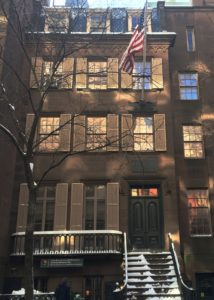 Teddy Roosevelt’s birthplace
Teddy Roosevelt’s birthplace
Located at 28 East 20th Street near Madison Square is a reconstruction of the brownstone townhouse where Theodore Roosevelt was born and lived until he was 14. Though the original 1848 rowhouse was demolished in 1916 (Theodore Roosevelt himself had no interest in preserving it.), the Women’s Roosevelt Memorial Association purchased the lot after his death in 1919 and rebuilt the brownstone in its original Greek Revival style. Today it is open as a house-museum and is filled with actual furnishings of the Roosevelt family or authentic period furnishings. Guided tours by National Park Service rangers are free.
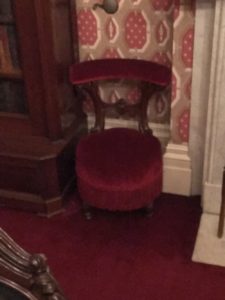 Roosevelt’s boyhood reading chair at the Theodore Roosevelt Birthplace
Roosevelt’s boyhood reading chair at the Theodore Roosevelt Birthplace
City Hall
New York City’s City Hall, built in 1812, has hosted dozens of presidents visiting New York City. One of the city’s nine full-sized statues of George Washington is inside, an 1857 cast of Jean-Antoine Houden’s 1792 statue of the first US president. The highlight is the Governor’s Room, which contains George Washington’s desk as well as 108 portraits, one of the richest collections of personal portraits in the United States. Among the paintings are nine John Trumbull portraits inclduing George Washington, Alexander Hamilton, and John Jay. The Trumbull Hamilton is the basis for his face on the $10 bill. City Hall is closed to the public except for guided tours, currently on Thursdays at 10:00 a.m. Registration is required.
Aside from visits by many US presidents, President’s Abraham Lincoln and Ulysses S Grant both lay in state at City Hall after their deaths.
The Great Hall of the Cooper Union
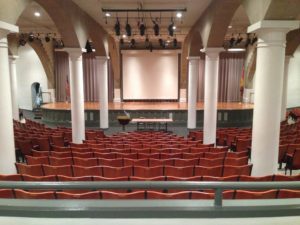 The Great Hall of the Cooper Union, where 8 presidents have spoken.
The Great Hall of the Cooper Union, where 8 presidents have spoken.  An exhibit outside the Great Hall
An exhibit outside the Great Hall
The Cooper Union was built by the philanthropist Peter Cooper in 1859 to provide free higher education as well as to provide a venue for ideas to be debated. Inside the Union’s Italianate brownstone Foundation Building at Cooper Square is the Great Hall of the Cooper Union, where at least 8 presidents have spoken, most significantly (then-candidate) Abraham Lincoln in 1860. Lincoln’s Cooper Union Address was seen as vital for Lincoln gaining the Republican nomination for the 1860 US Presidential Election.
From the outset, Peter Cooper intended the Great Hall to be open to a wide range of political ideas. Cooper was a Democrat (though an abolitionist as well) and happily opened the doors to Republicans like Lincoln in 1860. Other speakers here have included Ralph Nader, Hugo Chavez, Joseph Cambell, members of the women’s suffrage movement, and others. An exhibit of the Hall’s history is located inside. The Cooper Union is not open for visitors but events are held at the Great Hall which are open to the public.
Waldorf Astoria Hotel
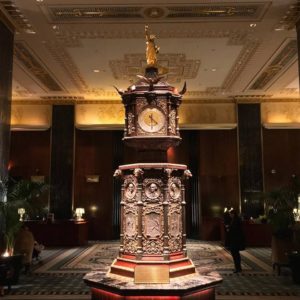 The 1893 clock inside the Waldorf-Astoria
The 1893 clock inside the Waldorf-Astoria
The Waldorf Astoria Hotel was the home of US Presidents in New York from Herbert Hoover to Barack Obama. The presidential suite is specifically designed to emulate the White House. The lobby, built in an elegant Art Deco style, is open to the public and one of the city’s amazing pubic spaces. The centerpiece in the lobby is a clock that was cast in England in 1893 and was displayed at the World’s Fair in Chicago in 1893. Topped by a miniature of the Statue of Liberty, the bronze column also has reliefs of 6 US presidents along with Queen Victoria and Benjamin Franklin.
Along with several US presidents, innumerable kings, queens, diplomats, politicians, and celebrities have stayed or lived at the Waldorf Astoria. Herbert Hoover lived here until his death in 1964. Songwriter Cole Porter lived her for 30 years and his grand piano is in the lobby. The Khrushchev family stayed here in 1959.
Roosevelt House
in 1908 Franklin and Eleanor Roosevelt moved into a Neo-Georgian townhouse purchased by Franklin’s mother Sara Delano Roosevelt. They lived here until the Roosevelt’s moved to the White House in 1933. It is today owned by Hunter College, which Eleanor Roosevelt had a long relationship with. It’s named the Sara Delano Roosevelt Memorial House, or the Roosevelt House.
The house is not a museum and lacks the rich collection of authentic furnishings that you see at the Theodore Roosevelt House. However, free guided tours on Saturdays go over the Roosevelts’ lives and political careers. After he was elected, Roosevelt assembled his political team here and planned much of the New Deal at this house. Here he appointed New Yorker Frances Perkins Secretary of Labor, the first woman to serve in the cabinet. One of her proposals would become what we call Social Security. The house contains many portraits of the Roosevelts and several political posters from the time.
Grants Tomb
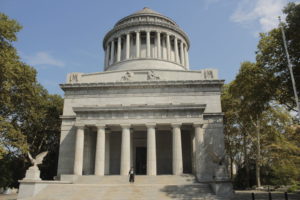 Grants Tomb, officially dedicated in 1897
Grants Tomb, officially dedicated in 1897 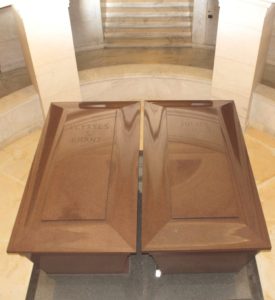 Sarcophagi for Ulysses and Julia Grant
Sarcophagi for Ulysses and Julia Grant
Two presidents have been born in New York City, and one is interred here. Ulysses S Grant is entombed the stunning Neoclassical General Grant National Memorial, popularly known as Grant’s Tomb. Grant was not from New York but lived his final years here. Late in his life, after many financial difficulties in his post-presidential years, he enjoyed renewed popularity due to the publication of his memoirs. He become a very popular citizen of the city, and when he died in 1885 unexpectedly of throat cancer, there was a public push to have him interred in New York City and build a suitable memorial. It took 12 years to plan and build and was dedicated in 1897. For many years it was New York’s most popular attraction, outdrawing the Statue of Liberty. In particular it was visited by Civil War veterans.
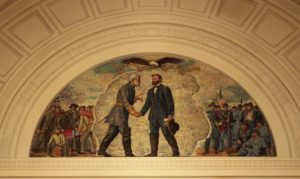 Mural of Grant and Lee at Appomattox inside Grants Tomb
Mural of Grant and Lee at Appomattox inside Grants Tomb
Even in a city with so many architectural riches, Grant’s Tomb is impressive. The design was inspired by the Mausoleum of Halicarnassus in ancient Turkey (a popular inspiration at the time, found in many New York buildings) and the Roman building Tropaeum Alpium in France; while inside it bears resemblance to Napoleon’s Tomb in Paris. The interior is rather simple, containing the two giant wooden sarcophagi–one for Ulysses S Grant and one for his wife Julia Grant. Inside are mosaics illustrating events in Grant’s career and busts of five Civil War generals.
Columbia University
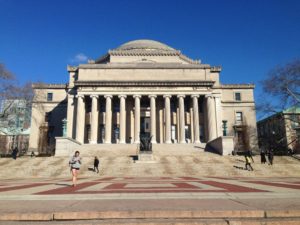 The Low Memorial Library at Columbia. It is the main building open to the general public and hosts a visitor center. Daniel Chester French’s Alma Mater statue stands in front.
The Low Memorial Library at Columbia. It is the main building open to the general public and hosts a visitor center. Daniel Chester French’s Alma Mater statue stands in front.
Columbia University, besides Harvard, Yale and the College of William and Mary, is perhaps the university most associated with US presidents. Theodore and Franklin Roosevelt studied here along with Barack Obama, while Dwight Eisenhower served as its president. The Roosevelts both studied law here but did not complete their degrees; both were awarded JDs posthumously. Barack Obama transferred to Columbia from Occidental College and finished with a B.A. in Political Science. Daniel D Tompkins, the sixth Vice-President of the United States, also studied at Columbia.
The campus in Morningside Heights, between 114th and 120th Streets. Built in the Beaux-Arts style by the architects McKim, Mead and White in the late 19th Century. It is considered one of the USA’s most beautiful college campuses. Though today most buildings are off limits to non students, the campus is still well worth a visit for the architecture alone. There is a visitor center at the Low Memorial Library building (open only Monday-Friday) and the university maintains a visitor information website with a self-guided tour.
Sagamore Hill National Historic Site
Sagamore Hill is Theodore Roosevelt’s summer home in Oyster Bay on the north shore of Long Island (the ‘Gold Coast’) and his primary residence for much of his adult life. He’s buried in nearby Youngs Memorial Cemetery. It is primarily accessible by car; it’s approximately one hour from the city. However, it is possible to take a train (to either Syosset or Oyster Bay) and then either take a taxi or a shuttle which is available in the summer only. See the Website for details.
Hyde Park: Home of Franklin D. Roosevelt National Historic Site
Theodore’s side of the family summered on Long Island, whole Franklin’s side summered at Hyde Park in the Hudson Valley. Springwood, the house where Roosevelt was born, was built around 1800 in the Federal Style, though portions have been added on since. It was purchased by Roosevelt’s father James in 1866 and Franklin was born here in 1882. Franklin would spend most of his life here, though he and Eleanor would also have the townhouse in the city. Roosevelt spent much of the summer here during his presidency. And the first Presidential Library was established on the grounds by FDR himself in 1941. Franklin and Eleanor are buried at the estate.
Again, Hyde Park is easiest to visit by car. It’s about an hour and a half north of NYC. You can also take a train to Poughkeepsie and either transfer by taxi or a shuttle service available in the summer.
Lincoln Depot Museum
 Statue of Lincoln in front of the Lincoln Depot Museum in Peekskill
Statue of Lincoln in front of the Lincoln Depot Museum in Peekskill
This wonderful museum is a surprising find. It was opened only in 2014. It is located in Peekskill NY (very near Bear Mountain State Park) 40 miles north of New York in the Hudson Valley inside a restored train station where Lincoln stopped en route to his inauguration in Washington from Springfield IL. He stopped briefly at the station and was greeted by William Nelson, a local lawyer with whom Lincoln had served in Congress years earlier. He spoke in front of 1,500 people who gathered to see the President-elect.
The small museum is filled with artifacts with a focus on Lincoln’s connections to New York State as well as the Civil War. Though easily walkable from the Peekskill train station, visiting by car would allow you to easily combine the visit with surrounding sites. Unfortunately the museum opens in April for the summer only but does host events on February 18th.
 A lithograph of Samuel Wright from an 1856 issue of the New York Clipper, captioned “Veteran Sam, the well-known cricketer.’
A lithograph of Samuel Wright from an 1856 issue of the New York Clipper, captioned “Veteran Sam, the well-known cricketer.’ An 1863 photo by Mathew Brady of Samuel Wright, left, holding a cricket bat, and Harry Wright holding a baseball.
An 1863 photo by Mathew Brady of Samuel Wright, left, holding a cricket bat, and Harry Wright holding a baseball.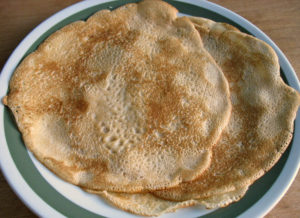 Russian blini
Russian blini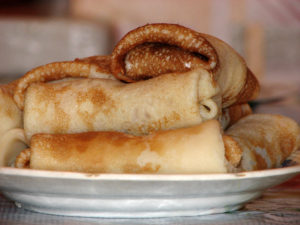 Blinchiki, or blintzes
Blinchiki, or blintzes Teremok, a popular Russian cafe chain that specializes in pancakes.
Teremok, a popular Russian cafe chain that specializes in pancakes. The Astor House Hotel, arguably New York’s first luxury hotel when it opened in 1836. It had gaslights and bathrooms on every floor, then the height of comfort. Lincoln stayed here several times.
The Astor House Hotel, arguably New York’s first luxury hotel when it opened in 1836. It had gaslights and bathrooms on every floor, then the height of comfort. Lincoln stayed here several times. The Washington Square Arch in Greenwich Village, built to commemorate Washington’s inauguration in NYC
The Washington Square Arch in Greenwich Village, built to commemorate Washington’s inauguration in NYC Bust of Franklin Roosevelt at Four Freedoms Park on Roosevelt Island
Bust of Franklin Roosevelt at Four Freedoms Park on Roosevelt Island Federal Hall on Wall Street, site of Washington’s 1st inauguration. In front is a statue of Washington by John Quincy Adams Ward
Federal Hall on Wall Street, site of Washington’s 1st inauguration. In front is a statue of Washington by John Quincy Adams Ward Model of the original Federal Hall and Washington’s Inauguration.
Model of the original Federal Hall and Washington’s Inauguration. Fraunces Tavern at the corner of Pearl and Broad Streets
Fraunces Tavern at the corner of Pearl and Broad Streets The Long Room, where Washington celebrated the end of the American Revolution in 1783
The Long Room, where Washington celebrated the end of the American Revolution in 1783  The presidential pew with painting of the Great Seal of the United States above.
The presidential pew with painting of the Great Seal of the United States above. Teddy Roosevelt’s birthplace
Teddy Roosevelt’s birthplace Roosevelt’s boyhood reading chair at the Theodore Roosevelt Birthplace
Roosevelt’s boyhood reading chair at the Theodore Roosevelt Birthplace The Great Hall of the Cooper Union, where 8 presidents have spoken.
The Great Hall of the Cooper Union, where 8 presidents have spoken.  An exhibit outside the Great Hall
An exhibit outside the Great Hall The 1893 clock inside the Waldorf-Astoria
The 1893 clock inside the Waldorf-Astoria Grants Tomb, officially dedicated in 1897
Grants Tomb, officially dedicated in 1897  Sarcophagi for Ulysses and Julia Grant
Sarcophagi for Ulysses and Julia Grant Mural of Grant and Lee at Appomattox inside Grants Tomb
Mural of Grant and Lee at Appomattox inside Grants Tomb The Low Memorial Library at Columbia. It is the main building open to the general public and hosts a visitor center. Daniel Chester French’s Alma Mater statue stands in front.
The Low Memorial Library at Columbia. It is the main building open to the general public and hosts a visitor center. Daniel Chester French’s Alma Mater statue stands in front. Statue of Lincoln in front of the Lincoln Depot Museum in Peekskill
Statue of Lincoln in front of the Lincoln Depot Museum in Peekskill